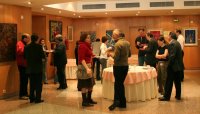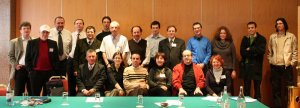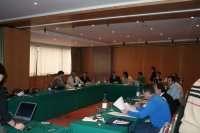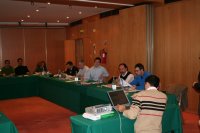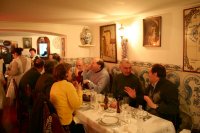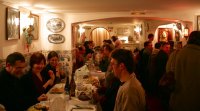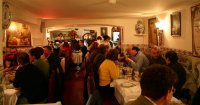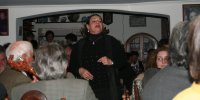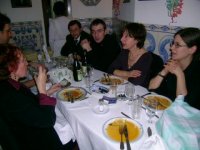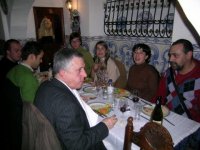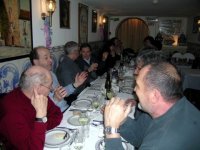Report on WG1 meeting: Electron and biomolecular interactions
Held at the Altis Park Hotel, Lisbon, Portugal
23 to 25 February 2006
Attendees | Aims and Objectives | Talks | Mission Statement | Report | Photographs
Local Host Meeting Secretary: Dr Paulo Limao-Vieira, Atomic and Molecular Collisions Laboratory, Department of Physics, New University of Lisbon, Portugal
In attendance (see also attendance sheets).
Working Group 1 members and invited experts
Jacqueline Bergès (University of Paris, France)
Stephan Denifl (University of Innsbruck, Austria)
David Field (University of Aarhus, Denmark). Chairman of WG1
Melvyn Folkard (Gray Cancer Institute, UK)
Gustavo Garcia (University of Madrid, Spain)
Jimena Gorfinkiel (Open University, UK)
Alexandre Giuliani (ICNS – CNRS, France)
Chantal Houée-Levin (university Paris XI, France)
Eugen Illenberger (Free University, Berlin, Germany)
Nykola Jones (University of Aarhus, Denmark)
Bratislav Marinkovic (University of Belgrade, Serbia,Yugoslavia)
Nigel Mason (Open University, UK)
Stefan Matejcik (Comenius University of Bratislava, Slovakia)
Paulo Limao-Vieira (New University of Lisbon, Portugal)
Jan Skalny (Comenius University of Bratislava, Slovakia)
Gosia Smialek (Open University, UK)
Marian Wolszczak (University of Lodz, Poland)Local Staff and students (attending formal sessions).
Ana Fernandes (New University of Lisbon, Portugal)
Quirina Ferreira (New University of Lisbon, Portugal)
Paulo Gomes (New University of Lisbon, Portugal)
Joao Lourenço (New University of Lisbon, Portugal)
Victor Kokhan (New University of Lisbon, Portugal)
Manuel Maneira (New University of Lisbon, Portugal)
Augusto Moutinho (New University of Lisbon, Portugal)
Marta Nobre (New University of Lisbon, Portugal)
Maria Raposo (New University of Lisbon, Portugal)
Paulo Ribeiro (New University of Lisbon, Portugal)
Filipe Silva (New University of Lisbon, Portugal)
Aims and objectives
This was the second meeting of WG1 of this COST Action. The purpose of this meeting was:
1) That each member of WG1, representing a team of scientists, should give a seminar describing their work in the field of electron/UV interactions with molecules, with special reference to processes of radiation damage.
2) That the Working group should discuss the achievements of the research conducted by the WG members since the establishment of the WG1 in 2004 and plan a future “Mission Statement” for WG1 2006-8.
3) That members would develop their existing collaborations and establish new links via COST financed visits. Report on the meeting
Talks
1) 13 talks were presented: Professor Illenberger (Free University Berlin): “Electron driven reactions in biologically relevant systems”, Professor Wolszczak (University of Lodz): "Experimental Studies of Electron Transfer within DNA Helix", Professor Mason (Open University): “UV and electron induced damage of DNA”, Professor Houée-Lévin (Université Paris Sud): “Role of secondary structure on radio-sensitivity of beta amyloid peptide”, Dr. Denifl (University of Innsbruck): “Electron impact ionization and attachment studies of biomolecules embedded in He droplets”, Dr. Giuliani (ICSN, France): "Mass spectrometric study of atmospheric pressure VUV photoionisation of peptides", Professor Garcia (CSIC - Madrid): “Low energy electron tracks in ionisation chambers”, Professor Field (University of Aarhus): “First experiments on the interaction of cold electrons with solids”, Dr. Bergès (Universite Paris Sud): “QM/MM study of electron addition on protein disulfide bonds”, Dr. Gorfinkiel (The Open University): “R-matrix calculations for biologically relevant systems”, Dr. Matejcik (Comenius University, Bratislava): “Electron attachment studies to selected aminoacids”, Professor Ribeiro (New University of Lisbon): “Analysis of biological structures by second harmonic generation” and Professor Marinkovic (University of Belgrade): "Elastic and inelastic electron scattering by biomolecules - the first step towards understanding of basic interactions”. These presentations sparked lively discussion.
Mission Statement
2) A “Mission Statement” has been available for WG1 since the start of the COST project. Although the mission statement clearly remains a very good description of the aims of WG1 after due discussion the WG decided to add a statement which makes clear that, at this stage in the COST project, we would like to make a more clear connection between radiation damage at the molecular level with clinical practice. We should like to able to use our results to influence the protocols that will in future be developed for heavy ion therapy, a relatively new venture in medical practice and one in which several laboratories in WG1 have plans (Gray Cancer Institute, Aarhus University). In this connection we would like to see more meetings in the second half of the COST project which involve members of other WGs. In our case we intend to plan a joint meeting with WG2 whose theme is ions and biomolecular interactions. Planning for this meeting will be made at the main COST meeting in Groningen June 6-9th 2006.
Report
3). There follows a brief report on some of the highlights and scientific discussions at the meeting.
The theme of WG1 is the experimental investigation of the interactions of electrons and light with biomolecules and water. Experimental investigations embrace a broad range of processes and studies of dissociative events, electron transfer, electronic and vibrational excitation, photon induced events and techniques of quantitative assessment of damage.
Electron transfer in peptides and proteins is one of the major processes for initiation and development of numerous diseases, triggering of cellular death, and amplification of radiation damage. Chantal Houée-Levin (Paris XI) reported studies the one-electron oxidation of beta amyloid peptide and related peptides. Free radical oxidation of this peptide is one of the prominent events in the course of Alzheimer's disease. It was shown that secondary structure drives the process: if the peptide is composed of beta sheets, methionine 35 is the target, if it is in alpha helix form, methionine is not oxidized. Without any defined structure, tyrosine 10 is mostly oxidized. Circular dichroism (CD) spectroscopy, especially synchrotron radiation CD, was highlighted as an important tool in these investigations. This is available at Daresbury Laboratory and at Aarhus University. Some very interesting and insightful calculations were reported by Jacqueline Bergès (Paris XI) on electron addition to protein disulphide bonds, showing that the stability of the S-S bonds depends strongly on the molecular conformation.
Jimena Gorfinkel (Open University) described how well established theoretical methods are being applied to electron collisions with biologically relevant molecules. The quality of the results is lower than for small targets with only a few nuclei and less than 40 electrons, but results are promising. Elastic and electronically inelastic cross-sections as well as resonance parameters are calculated, but the analysis of the dissociation products can, at present, only be performed qualitatively
Data for very low energy electron collisions with biomolecules (bases and aminoacids) were reported from the Bratislava /Innsbruck groups (Stephan Denifl, University of Innsbruck; Stefan Matejcik Comenius University of Bratislava) showing the sensitivity of biomolecules to electrons in the gas phase and in liquid helium droplets and the strong dependence of electron energy associated with this. David Field (Aarhus) showed data for very low energy electrons interacting with solid acetic acid and with fluorobenzene, in the first tests of a new instrument now functioning at Aarhus University. Data for rotational state to rotational state transitions collisions in gas phase water induced by very cold electrons were also shown. The significance or otherwise of dipole bound states in electron collisions with highly polar biomolecules was discussed and may have bearing on the interpretation of the data emerging from Innsbruck, Bratislava and the Lincoln (Nebraska) laboratories.
Marian Wolszczak (University of Lodz, Poland) discussed photochemistry of biomolecules. The most important conclusion of these studies is the observation that the diffusion of the cationic species along the anionic polyelectrolyte is severely restricted due to their electrostatic and/or hydrophobic interactions with polymer. The transfer of the quencher molecule from the trap (complex between quencher and monomer units of polyelectrolyte in which both electrostatic and hydrophobic interactions are involved) to excited probe can be regarded as a multistep diffusion process with a single hopping event determined by the energy required for quencher release from the trap. Results of our time-resolved studies suggest that the DNA base pair stack is a poor medium for long-range photoinduced electron transfer between intercalated donor and acceptor. However DNA may facilitate electron transfer over short distances of three or four interspersed base pairs. A relatively short distance of electron transfer in DNA in solution from base radical anions to electron- affinic intercalators (3 - 4 base pairs) is also found in the pulse radiolysis studies. It can be due to competing protonation of certain base radical anions.
Bratislav Marinkovic (University of Belgrade) and Eugen Illenberger (Free University, Berlin, Germany) gave customarily lucid accounts of electron-driven chemistry, including mention of electron driven breakage of hydrogen bonds. Alexandre Giuliani (ICSN, France) treated higher energy VUV photon interactions, whilst Nigel Mason confronted both electron driven and photon driven damage in DNA, mentioning the pioneering work of Gosia Smialek (present at the meeting) involving the use of AFM in visualising strand breaks directly. Gustavo Garcia (Madrid) reported how fundamental data collected in electron molecule interactions may be used to model track damage. In a rather new field, Professor Ribeiro (New University of Lisbon) described how one may, at least in principle, analyse the properties of biomolecules through non-linear optical effects and second harmonic generation.
The brief of WG1 is to continue the studies outlined above and other studies to build up a body of knowledge on which to base realistic models of electron and photon-induced damage in biological cells. As mentioned above, WG1 is keen on complementary information and interlinking with the other working groups, concerned for example with the effects of ions on biomolecules and the extension into true physiological environments, including track structure in cells. It was also stressed by Nigel Mason and others that an important product of our work is an understanding of the chemical activation of biomolecules on surfaces. Some of the data which we produce are likely to be fundamental to fabrication in bionanotechnology. A number of members were clearly very interested in arranging mutual visits.
In summary, there was a strong feeling that this was a very useful and fruitful contact at the scientific level among workers from a number of different backgrounds, spanning those with strong medical interests (Gray Cancer Institute and CSIC, Madrid), via those who work in radiation chemistry in the aqueous phase (Paris XI) to those who have up to the present dealt with electron collisions largely in the gas phase (several of the groups present).
The Next WG1 meeting will be arranged in 2007 at a venue as yet undetermined. The WG was keen that this meeting will involve discussions of the applications of the work and thus involve clinicians and radiologists.
Dr Paulo Limao-Vieira
March 4 2006
Photographs
To view a larger version of the photograph, click on the image.
Attendees | Aims and Objectives | Talks | Mission Statement | Report
